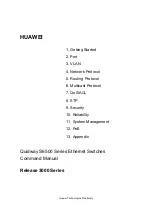
©
National Instruments Corporation
6-1
6
Programmable Function
Interfaces (PFI)
The 10 Programmable Function Interface (PFI) pins allow timing signals to
be routed to and from the I/O connector of a device.
Inputs
An external timing signal can be input on any PFI pin and multiple timing
signals can simultaneously use the same PFI pin. This flexible routing
scheme reduces the need to change the physical connections to the I/O
connector for different applications. Refer to the
section of Chapter 7,
, for more information.
When using the PFI pin as an input, you can individually configure each
PFI for edge or level detection and for polarity selection. You can use the
polarity selection for any of the timing signals, but the edge or level
detection depends upon the particular timing signal being controlled. The
detection requirements for each timing signal are listed within the section
that discusses that signal.
In edge-detection mode, the minimum pulse width required is 10 ns. This
applies for both rising-edge and falling-edge polarity settings. There is no
maximum pulse width requirement in edge-detect mode.
In level-detection mode, there are no minimum or maximum pulse width
requirements imposed by the PFI signals, but there can be limits imposed
by the particular timing signal being controlled.
Outputs
You can also individually enable each PFI pin to output a specific internal
timing signal. For example, if you need the Counter 0 Source signal as an
output on the I/O connector, software can turn on the output driver for the
PFI 8/CTR 0 SRC pin. This signal, however, cannot be output on any other
PFI pin.
















































